[English] 日本語
 Yorodumi
Yorodumi- PDB-1glc: CATION PROMOTED ASSOCIATION (CPA) OF A REGULATORY AND TARGET PROT... -
+ Open data
Open data
- Basic information
Basic information
| Entry | Database: PDB / ID: 1glc | ||||||
|---|---|---|---|---|---|---|---|
| Title | CATION PROMOTED ASSOCIATION (CPA) OF A REGULATORY AND TARGET PROTEIN IS CONTROLLED BY PHOSPHORYLATION | ||||||
 Components Components |
| ||||||
 Keywords Keywords | PHOSPHOTRANSFERASE | ||||||
| Function / homology |  Function and homology information Function and homology informationnegative regulation of carbohydrate metabolic process / regulation of carbohydrate utilization / glycerol-3-phosphate metabolic process / negative regulation of maltose transport / enzyme IIA-maltose transporter complex / negative regulation of transmembrane transport / glycerol kinase / glycerol kinase activity / glycerol metabolic process / phosphoenolpyruvate-dependent sugar phosphotransferase system ...negative regulation of carbohydrate metabolic process / regulation of carbohydrate utilization / glycerol-3-phosphate metabolic process / negative regulation of maltose transport / enzyme IIA-maltose transporter complex / negative regulation of transmembrane transport / glycerol kinase / glycerol kinase activity / glycerol metabolic process / phosphoenolpyruvate-dependent sugar phosphotransferase system / transmembrane transporter complex / glycerol catabolic process / kinase activity / DNA damage response / zinc ion binding / ATP binding / metal ion binding / identical protein binding / membrane / cytosol Similarity search - Function | ||||||
| Biological species |  | ||||||
| Method |  X-RAY DIFFRACTION / Resolution: 2.65 Å X-RAY DIFFRACTION / Resolution: 2.65 Å | ||||||
 Authors Authors | Feese, M.D. / Meadow, N.D. / Roseman, S. / Pettigrew, D.W. / Remington, S.J. | ||||||
 Citation Citation |  Journal: Proc.Natl.Acad.Sci.USA / Year: 1994 Journal: Proc.Natl.Acad.Sci.USA / Year: 1994Title: Cation-promoted association of a regulatory and target protein is controlled by protein phosphorylation. Authors: Feese, M. / Pettigrew, D.W. / Meadow, N.D. / Roseman, S. / Remington, S.J. #1:  Journal: Science / Year: 1993 Journal: Science / Year: 1993Title: Three-Dimensional Structure of the Regulatory Complex of Escherichia Coli III-Glc with Glycerol Kinase Authors: Hurley, J.H. / Worthylake, D. / Faber, H.R. / Meadow, N.D. / Roseman, S. / Pettigrew, D.W. / Remington, S.J. | ||||||
| History |
|
- Structure visualization
Structure visualization
| Structure viewer | Molecule:  Molmil Molmil Jmol/JSmol Jmol/JSmol |
|---|
- Downloads & links
Downloads & links
- Download
Download
| PDBx/mmCIF format |  1glc.cif.gz 1glc.cif.gz | 140.6 KB | Display |  PDBx/mmCIF format PDBx/mmCIF format |
|---|---|---|---|---|
| PDB format |  pdb1glc.ent.gz pdb1glc.ent.gz | 106.9 KB | Display |  PDB format PDB format |
| PDBx/mmJSON format |  1glc.json.gz 1glc.json.gz | Tree view |  PDBx/mmJSON format PDBx/mmJSON format | |
| Others |  Other downloads Other downloads |
-Validation report
| Arichive directory |  https://data.pdbj.org/pub/pdb/validation_reports/gl/1glc https://data.pdbj.org/pub/pdb/validation_reports/gl/1glc ftp://data.pdbj.org/pub/pdb/validation_reports/gl/1glc ftp://data.pdbj.org/pub/pdb/validation_reports/gl/1glc | HTTPS FTP |
|---|
-Related structure data
- Links
Links
- Assembly
Assembly
| Deposited unit | 
| ||||||||
|---|---|---|---|---|---|---|---|---|---|
| 1 | 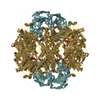
| ||||||||
| 2 | 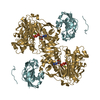
| ||||||||
| 3 | 
| ||||||||
| Unit cell |
| ||||||||
| Atom site foot note | 1: CIS PROLINE - PRO G 354 | ||||||||
| Details | THE CRYSTAL CONTAINS TETRAMERS OF THE GLYCEROL KINASE/III-GLC COMPLEX WITH 222 POINT-GROUP SYMMETRY. THE TETRAMER IS LOCATED AT THE INTERSECTION OF THREE CRYSTALLOGRAPHIC TWO-FOLD AXES. THE FOLLOWING TRANSFORMATIONS WILL PRODUCE A TETRAMER OF THE COMPLEX WHEN APPLIED TO THE COORDINATES IN THIS ENTRY: TRANSFORM 1 (-X, 1-Y, Z) -1.0 0.0 0.0 0.0 0.0 -1.0 0.0 125.16 0.0 0.0 1.0 0.0 TRANSFORM 2 ( X, 1-Y, -Z) 1.0 0.0 0.0 0.0 0.0 -1.0 0.0 125.16 0.0 0.0 1.0 0.0 TRANSFORM 3 (-X, Y, -Z) -1.0 0.0 0.0 0.0 0.0 1.0 0.0 0.0 0.0 0.0 -1.0 0.0 |
- Components
Components
-Protein , 2 types, 2 molecules FG
| #1: Protein | Mass: 18141.834 Da / Num. of mol.: 1 Source method: isolated from a genetically manipulated source Source: (gene. exp.)  References: UniProt: P69783, protein-Npi-phosphohistidine-sugar phosphotransferase |
|---|---|
| #2: Protein | Mass: 56162.352 Da / Num. of mol.: 1 Source method: isolated from a genetically manipulated source Source: (gene. exp.)  |
-Non-polymers , 5 types, 46 molecules 

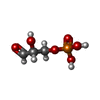






| #3: Chemical | ChemComp-ZN / |
|---|---|
| #4: Chemical | ChemComp-MG / |
| #5: Chemical | ChemComp-G3H / |
| #6: Chemical | ChemComp-ADP / |
| #7: Water | ChemComp-HOH / |
-Details
| Nonpolymer details | THE COMPLEX OF GLYCEROL KINASE AND III-GLC CREATES AN INTERMOLECULAR ZINC BINDING SITE. HISTIDINES ...THE COMPLEX OF GLYCEROL KINASE AND III-GLC CREATES AN INTERMOLEC |
|---|
-Experimental details
-Experiment
| Experiment | Method:  X-RAY DIFFRACTION X-RAY DIFFRACTION |
|---|
- Sample preparation
Sample preparation
| Crystal | Density Matthews: 3.48 Å3/Da / Density % sol: 64.66 % | ||||||||||||||||||||||||||||||
|---|---|---|---|---|---|---|---|---|---|---|---|---|---|---|---|---|---|---|---|---|---|---|---|---|---|---|---|---|---|---|---|
| Crystal grow | *PLUS pH: 6.1 / Method: vapor diffusion, hanging drop | ||||||||||||||||||||||||||||||
| Components of the solutions | *PLUS
|
-Data collection
| Radiation | Scattering type: x-ray |
|---|---|
| Radiation wavelength | Relative weight: 1 |
- Processing
Processing
| Software | Name: TNT / Classification: refinement | ||||||||||||||||||||||||||||||
|---|---|---|---|---|---|---|---|---|---|---|---|---|---|---|---|---|---|---|---|---|---|---|---|---|---|---|---|---|---|---|---|
| Refinement | Resolution: 2.65→14.5 Å / Rfactor obs: 0.166 | ||||||||||||||||||||||||||||||
| Refinement step | Cycle: LAST / Resolution: 2.65→14.5 Å
| ||||||||||||||||||||||||||||||
| Refine LS restraints |
| ||||||||||||||||||||||||||||||
| Software | *PLUS Name: TNT / Classification: refinement | ||||||||||||||||||||||||||||||
| Refinement | *PLUS Rfactor obs: 0.166 | ||||||||||||||||||||||||||||||
| Solvent computation | *PLUS | ||||||||||||||||||||||||||||||
| Displacement parameters | *PLUS | ||||||||||||||||||||||||||||||
| Refine LS restraints | *PLUS
|
 Movie
Movie Controller
Controller


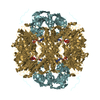
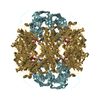
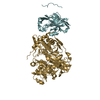
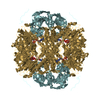
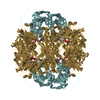



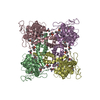
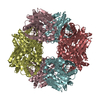
 PDBj
PDBj




